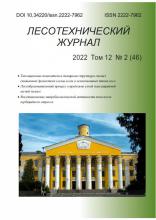Voronezh State University of Forestry and Technologies Named After G.F. Morozov
Voronezh, Voronezh, Russian Federation
Voronezh State Agricultural University after Emperor Peter the Great (kafedra zemledeliya i agroekologii, docent)
Voronezh, Voronezh, Russian Federation
Voronezh, Voronezh, Russian Federation
Voronezh, Voronezh, Russian Federation
The article presents the results of the investigation of the species composition of trees at the canopy layer in upland oak forest on the sample slots. On the basis of the trees-presence formula the degree of realization the competitiveness, tolerance and reactive strategies was determined. It was found that the quantity of Quercus robur increases the competitiveness degree of the community. The contribution of other trees in the amplification of this population strategy is insignificant. Relatively high values of competitiveness are forming oaks in the amount not less than 40% of the total number of trees.
population strategy, competitiveness, tolerance, responsiveness, upland oak forest.
1. Parahnevich M.I. [i dr.]. Praktikum po landshaftovedeniju i kartografirovaniju pochvennogo pokrova [Practical work on mapping of landscape and soil]. Voronezh, 2003, 201 p. (In Russian). EDN: https://elibrary.ru/VGHPCX
2. Sannikov S.N. Jekologo-geneticheskie principy vydelenija i klassifikacii lesnyh geneticheskih rezervatov [Ecological and genetic principles for the selection and classification of forest genetic reserves]. Jekologija [Russian Journal of Ecology], 2015, no. 1, pp. 3-8. (In Russian). DOI: https://doi.org/10.7868/S0367059715010151; EDN: https://elibrary.ru/TFVPZT
3. Chernenkova T.V. Bioraznoobrazie lesnogo pokrova pri tehnogennom zagrjaznenii [Biodiversity of forest vegetation under industrial pollution]. Jekologija [Russian Journal of Ecology], 2014, no. 1, pp. 3-13. (In Russian). DOI: https://doi.org/10.7868/S0367059714010041; EDN: https://elibrary.ru/RTOWEX
4. Kolomyc Je.G. Kolichestvennaja ocenka funkcional'noj ustojchivosti lesnyh jekosistem [Quantitative assessment of functional stability of forest ecosystems]. Jekologija [Russian Journal of Ecology], 2015, no. 2, pp. 83-94. (In Russian). DOI: https://doi.org/10.7868/S0367059715020067; EDN: https://elibrary.ru/TLOVLX
5. Vasilevich V.I. Funkcional'noe raznoobrazie rastitel'nyh soobshhestv [Functional diversity in plant communities]. Botanicheskij zhurnal [Botanical journal], 2016, Vol. 161, no. 7, pp. 776-795. (In Russian). DOI: https://doi.org/10.1134/S0006813616070024 ; EDN: https://elibrary.ru/WHFCZX
6. Ramensky L.G. Vvedenie v kompleksnoe pochvenno-geobotanicheskoe issledovanie zemel' [Introduction to the complex soil-geobotanical investigation of territory]. Moscow, 1938, 620 p. (In Russian).
7. Smirnova O.V. Struktura travjanogo pokrova shirokolistvennyh lesov [The structure of the grass cover of deciduous forests]. Moscow, 1987, 208 p. (In Russian). EDN: https://elibrary.ru/RECNIZ
8. Vostochnoevropejskie lesa: istorija v golocene i sovremennost' [Eastern European forests: history in the holocene and the present]. Moscow, 2004, Bd. 1, 479 p. (In Russian).
9. Anuchin N.P. Lesnaja taksacija [Forest classification]. Moscow, 1982, 552 p. (In Russian).
10. Kirik A.I., Parakhnevic T.M. Vlijanie populjacij klena jasenelistnogo na strukturu pojmennyh lesov Verhnego Dona [The influence of Acer negundo populations on the structure of floodplain forests of the Upper Don]. Bioraznoobrazie: problemy izuchenija i sohranenija: materialy Mezhdunar. nauch. konf., posvjashh. 95-letiju kafedry botaniki Tverskogo gosudarstvennogo universiteta [Biodiversity: problems of study and preservation: Materials of Intern. scientific. conf., dedicated 95th Anniversary of the Department of Botany of the Tver' State University]. Tver, 2012, pp. 355-357. (In Russian). EDN: https://elibrary.ru/UZUTSH
11. Grime J.P. Plant strategies and vegetation processes. N.Y., 1979, 222 p.












